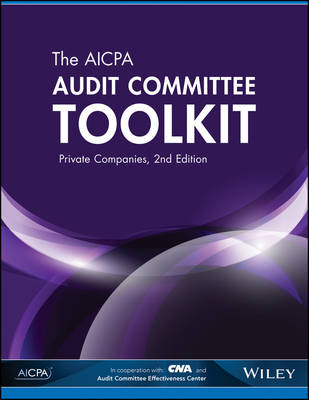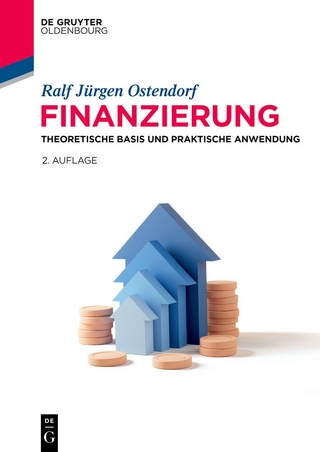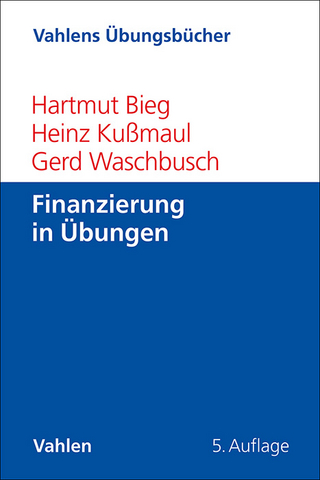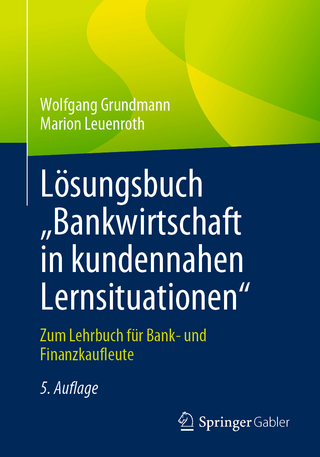
The AICPA Audit Committee Toolkit
American Institute of Certified Public Accountants (Verlag)
978-1-940235-46-2 (ISBN)
- Titel ist leider vergriffen;
keine Neuauflage - Artikel merken
This newly revised edition of the popular audit committee toolkit is written to help audit committees of private companies to achieve best practices for managing and incorporating their role in the organization. New to this edition of the toolkit * Updated with new COSO Framework (May 2013) * Improved format for forms and checklists * Updated with regulatory changes * Includes IFRS guidance Now with downloadable Microsoft Word tools and checklists, this Toolkit offers a broad sampling of matrices, reports, questionnaires and other pertinent materials specifically tailored to private companies and designed to make audit committee best practices actionable.
Founded in 1887, the American Institute of Certified Public Accountants (AICPA) represents the CPA and accounting profession nationally and globally regarding rule-making and standard-setting, and serves as an advocate before legislative bodies, public interest groups and other professional organizations. The AICPA develops standards for audits of private companies and other services by CPAs; provides educational guidance materials to its members; develops and grades the Uniform CPA Examination; and monitors and enforces compliance with the accounting profession s technical and ethical standards. The AICPA s founding established accountancy as a profession distinguished by rigorous educational requirements, high professional standards, a strict code of professional ethics, a licensing status and a commitment to serving the public interest.
Acknowledgements iii Preface v Part I: Audit Committee Administration Chapter 1 Benefits of a Private Company Audit Committee 3 Financial Benefits 3 Better Decision Making 4 Stronger Relationships With Stakeholders 4 Other Benefits 5 Chapter 2 Audit Committee Member Roles and Responsibilities 7 Audit Committee Process and Procedures 8 Oversight of the Financial Reporting Process 8 Oversight of Financial Reporting 9 Oversight of the Independent Auditor 9 Oversight of the Internal Audit Function 9 Oversight of Risk Management 10 Oversight of Ethics and Compliance 10 Limitation of Audit Committee s Role 10 Chapter 3 Audit Committee Charter Matrix 11 Chapter 4 Audit Committee Financial Expert Decision Tree 29 Audit Committee Financial Expertise 29 Alternative Approaches 30 Audit Committee Financial Expert 31 Chapter 5 Sample Request for Proposal Letter for CPA Services and Qualifications (Private Company) 33 Background of ABC Company 34 Services to Be Performed 34 Key Personnel 35 Relationship With Prior CPA Service Provider 35 Other Information 36 Your Response to This Request for Proposal 36 Background on the Firm 36 Experience in Our Industry 37 Expected Approach to This Audit 37 Evaluation of Proposals 37 Chapter 6 AICPA Peer Reviews and PCAOB Inspections of CPA Firms: An Overview 39 Peer Review of a CPA Firm 39 Peer Review Reports 40 Common Misconceptions of Peer Review 41 Questions for the Auditor Regarding Peer Review 41 PCAOB Inspection 42 Questions for the Audit Committee Regarding the PCAOB Inspection 42 Chapter 7 Guidelines for Hiring the Chief Audit Executive (CAE) 45 Role of the Audit Committee in Hiring and Evaluating the CAE 45 CAE Qualifications 45 Chapter 8 Engaging Independent Counsel and Other Advisers 51 Part II: Key Responsibilities Chapter 9 Internal Control: Guidelines and Tool for the Audit Committee 55 Internal Control Primer 55 Internal Control Effectiveness 56 What Internal Control Cannot Do 57 Roles and Responsibilities 57 Internal Control Over Financial Reporting 59 Key Terms in Internal Control Over Financial Reporting Control 60 ICFR Results 62 Conclusion 62 Internal Control Checklist of COSO Essentials for the Board 63 Chapter 10 Fraud and the Responsibilities of the Audit Committee: An Overview 71 Definition and Categories of Fraud 71 Roles of the Audit Committee in the Prevention, Deterrence, Investigation, and Discovery or Detection of Fraud 72 Governance Considerations 73 Expertise of Forensic Accounting Consultants 74 When Fraud Is Discovered 74 Conclusion 75 Chapter 11 Whistleblower Policy: Complaint Reporting Procedures and Tracking Report 77 Reasons for Tool 77 Whistleblower Common Practices Checklist 79 Sample Procedures For Handling Complaints (Whistleblower Policy) 82 Statement of Purpose 82 Employee Complaints 82 Director Complaints 82 Other Complaints 83 Processing Complaints 83 Retention of Complaints 83 Chapter 12 Issues Report From Management 85 Defining Significant Issues, Critical Accounting Estimates, Significant Unusual Transactions, and Judgments 85 Sample Issues Report From Management 87 Issues Report From Management 88 Chapter 13 Guidelines and Questions for Conducting an Audit Committee Executive Session 89 What Is an Executive Session? 89 Additional Questions to Consider: Tool for Audit Committee Members 91 Chapter 14 Independent Auditor Communications with Audit Committee 111 Background 111 Objectives of Communications 111 Timing of Communications 112 1 Terms of the Firm s Audit Engagement 112 2 Inquiries About Matters Relevant to the Audit 113 3 Audit Strategy, Timing, and Approach 113 4 Evaluation of the Quality of the Company s Financial Reporting 114 5 Other Significant Communications 115 Illegal Acts 117 Internal Control Matters 117 Fraud 118 Chapter 15 Responding to the Identification of a Material Weakness A Checklist for the Audit Committee 119 Background 119 Internal Control Evaluation Requirements 119 Responding to the Identification of a Material Weakness 120 Additional Resources 120 Steps the Audit Committee Can Consider If Faced With an Adverse Report on Internal Control 121 Part III: Performance Evaluation Chapter 16 Evaluating the Internal Audit Function: Questions to Consider 127 Chapter 17 Evaluating the Independent Auditor: Questions to Consider 131 Questions for Audit Committee Members 131 Questions for Management and/or Internal Audit 134 Chapter 18 Conducting an Audit Committee Self-Evaluation: Questions to Consider 137 Part IV: Other Tools Chapter 19 Enterprise Risk Management: A Primer on the COSO Framework 143 Enterprise Risk Management Primer Basics of ERM and Its Relationship to Internal Control 144 Relationship Between COSO Enterprise Risk Management Integrated Framework and Internal Control Integrated Framework 145 Other Key Terms in Enterprise Risk Management 147 Portfolio View of Residual Risk Example 148 Roles and Responsibilities 148 Limitations of Enterprise Risk Management 149 Conclusion 150 Enterprise Risk Management: A Tool for Strategic Oversight 150 Chapter 20 Enteprise Risk Management: A Tool for Strategic Oversight 151 Chapter 21 SEC Final Rule on Audit Committee Financial Experts 157 A Audit Committee Financial Experts 157 1 Title of the Expert 157 2 Disclosure of the Number and Names of Audit Committee Financial Experts 158 3 Disclosure of Independence of Audit Committee Financial Experts 158 4 Definition of Audit Committee Financial Expert 159 5 Safe Harbor from Liability for Audit Committee Financial Experts 164 6 Determination of a Person s Status as an Audit Committee Financial Expert 165 7 Location of Audit Committee Financial Expert Disclosure 165 8 Change in Item Number 165 Chapter 22 IFRS Implementation 167 Implementation 167 Stage 1: Assessment 168 Stage 2: Conversion 168 Stage 3: Integration 169 Conclusion 170 Chapter 23 Resources for Audit Committees 171
| Erscheinungsdatum | 29.12.2016 |
|---|---|
| Verlagsort | NC |
| Sprache | englisch |
| Maße | 214 x 276 mm |
| Gewicht | 492 g |
| Themenwelt | Wirtschaft ► Betriebswirtschaft / Management ► Finanzierung |
| Wirtschaft ► Betriebswirtschaft / Management ► Rechnungswesen / Bilanzen | |
| ISBN-10 | 1-940235-46-4 / 1940235464 |
| ISBN-13 | 978-1-940235-46-2 / 9781940235462 |
| Zustand | Neuware |
| Haben Sie eine Frage zum Produkt? |
aus dem Bereich


